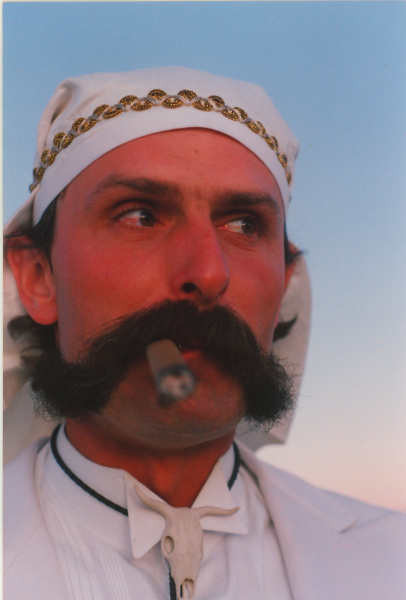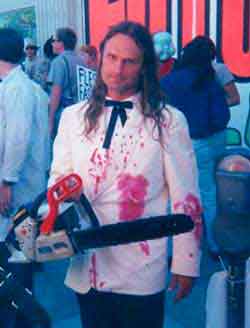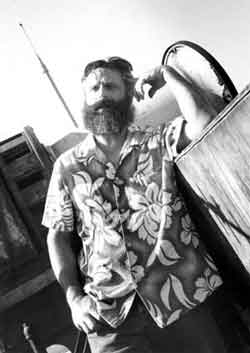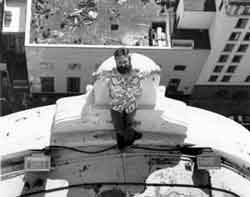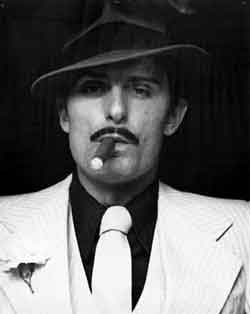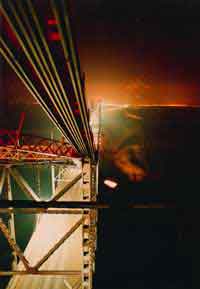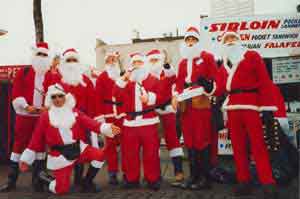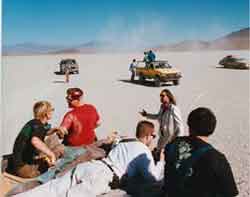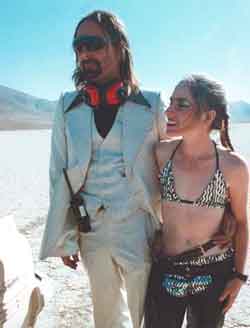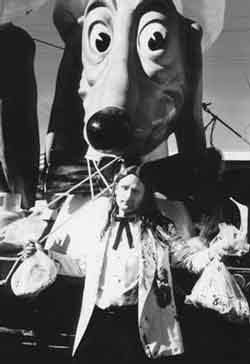The following article is from Comet Magazine, and is best viewed there. The link has been intermittedly unresponsive, and the article is reproduced below for archival purposes.
Who the hell is John Law?
An interview with prankster John Law
by Mark Beers
You might not know his name, but those of you who consider yourselves fringe culture aficionados will recognize at least one of these: The Suicide Club, Cacophony Society, Survival Research Laboratories (SRL), Seemen, People Hater, Defenestration, Circus Ridikulus and Laughing Squid. These are the people who help prevent cultural arteriosclerosis. During the past twenty-plus years, Law has conspired and collaborated on many projects and in many roles: master builder of doomed props in SRL shows, master negotiator for his fellow Santa pranksters on the brink of arrest. He has rappel-danced on the side of buildings, gunned down an Oldsmobile station wagon in the desert, scaled all the bridges in San Francisco and New York City, led spelunkers through the Oakland sewers - and this is the short list. Much of what he has done is creative, participatory fun, the most famous of which, Burning Man, would never have made its virgin excursion to the Black Rock Desert ten years ago without Law's ingenuity and energy. But even without Burning Man, a look at the broad range of his activities over the last twenty years attests to Law's vital, catalytic influence on the evolution of San Francisco culture and art.
A juvi joins The Suicide Club
John Law's career as a prankster (a label he prefers to "artist") began in 1977 when he joined The Suicide Club shortly after arriving in San Francisco at the age of eighteen. Law says of the club's chief organizer and avatar, Gary Warne, "He was a very close friend, kind of my mentor and the only real visionary I've ever worked with - in fact, the most interesting and most amazing person I've ever known in my life." (Warne died at the age of thirty-five of a heart attack in 1983, about a year after the club had disbanded.)
The Suicide Club borrowed theme and title from Robert Louis Stevenson's novel about a group of people who lived each day as though it were their last. To invoke this carpe diem spirit, club members created events which required them to challenge their fears. In Law's case, terror meant stripping naked on a cable car (an Easter 1977 event - maybe you've seen the "Welcome to San Francisco" postcard). "It scared the fuck out of me. My stomach was tied up in knots. And then when we did it, I was enormously relieved - who gives a shit if I'm naked." That experience, according to Law, exorcised worry from future public performances.
In contrast to disrobing in public, climbing a bridge or rappelling into an empty, 400-foot-deep gas storage tank "did not scare me. I love climbing. I have no fear of heights at all. I've got a real kick out of taking people climbing and letting them see that they could do it." Law has favored urban structures for events both during and since his Suicide Club days. "Urban environments are filled with what I call negative space - underground, on top of buildings, between freeways, on bridge towers - that average people don't really care about or never observe and comprehend, not that they couldn't. Everyone I take on a bridge climb for the first time never looks at a bridge the same way again, ever. The next time they cross it and think, 'Oh yeah!'"
Part of the thrill of such urban exploration, in addition to its inherent physical dangers, comes from the threat of getting caught, a sensation that Law admits stems from the recklessness of his youth. Now, at 41, John Law reminisces about his life, occasionally fingering his ample beard (picture a young Ulysses S. Grant), with a courtesy and thoughtfulness unbecoming of a onetime juvenile delinquent.
"My parents were pretty moral and ethical, but I was a wild and crazy kid, hooked up with people who were doing exciting stuff - stealing cars and breaking into houses. I was really attracted to that, but I had a lot of misgivings about the morality of stealing. Then I joined The Suicide Club in 1977 and here was a group that was actually philosophically driven in an extremely ethical sense - we did a lot of illegal stuff, but we didn't do anything I would consider unethical or immoral."
One of the first events in which Law participated graphically illustrates this distinction. It was one of the group's "Enter the Unknown" events, where participants showed up without knowing what the organizers had planned. "Because I was one of the climber guys, they asked me to help people get up on the roof of this building where the organizers sat us down with all these weird implements including buckets and rolls of paper and said, 'Okay, this is what we're going to do: we're going to change these two back-to-back billboards on the roof of this building.'
The original billboard read on both sides: WARNING! A PRETTY FACE ISN'T SAFE IN THIS CITY. FIGHT BACK WITH SELF-DEFENSE. THE NEW MOISTURIZER FROM MAX FACTOR. 'We want you to decide what they're going to say when we're done changing them.' So in the best, ridiculous San Francisco democratic tradition we sat there and argued for two hours and finally came up with two captions: WARNING! A PRETTY FACE ISN'T SAFE IN THIS CITY. FIGHT CRAP WITH SELF-RESPECT. Which I thought was really dull. I mean it got the point across but it wasn't very interesting. On the other side, the new message read: WARNING! A PRETTY FACE ISN'T SAFE IN THIS CITY. FIGHT BACK WITH SELF-ABUSE. THE NEW MUTILATOR. AX FACTOR. I liked that one better. We got caught, but charges were dropped later."
Two of the participants, Irving Glick and Jack Napier (the latter of whom Law - somewhat jokingly - characterized as "bull-headed and autocratic, but funny"), were inspired to create the Billboard Liberation Front (BLF). The BLF's most recent campaign to "improve" advertising in public space got people to think differently about Apple's appropriation of the images of famous people on their "Think Different" billboards. Amelia Earhart's image was accompanied with the message "Think Doomed"; the Dalai Lama's, with "Think Disillusioned"; Ted Turner's with "Think Dividends". The BLF have never been caught since that first Suicide Club event.
The Cacophony Society rises from the ashes of The Suicide Club
The preponderance of bigger, more grandiose events, organized by fewer and fewer members brought about the eventual demise of The Suicide Club in 1982. The club died, says Law, "because after six years, everybody was sleeping with everybody else, and people were bored." In 1986, six former Suicide Club members formed the Cacophony Society. (Law joined several months later - he had recently ended a relationship with one of the founders and delayed his participation in the group until they were on better terms.) In contrast to the insular, publicity-shy Suicide Club, the Cacophony Society was more open to the press and public. Law describes the Cacophony Society as "a group populated by geeks and nerds, myself included - a group of misfits, even more so than The Suicide Club."
One Cacophony Society event which got plenty of attention from the police as well as from the press was a beautifully arranged marriage of anti-capitalist zeal and Christmas spirit dubbed Santasm. In December, 1994, 30 cheap-suited Santas stormed downtown San Francisco venue by holiday venue. At Macys, Santas rode the escalators and chanted "charge it, charge it"; out on the street, one naughty Santa (Law) got strung up and hung from a lamppost in front of the St. Francis Hotel while another guzzled booze from a Pine Sol bottle. Crashing a Christmas ball at the Fairmont, the Santas drank wine, ate hors d'oeuvres, danced and were even applauded by the guests. Law recalls that, while dancing with a grandmotherly party guest, a security guard came up to him and said, sotto voce, "Get the fuck out of here!" So they left and hit the Tonga Room, but before they could get in their first dance, security booted all the Santas out, even as the tiki island combo played "Here Comes Santa Claus." Later in the evening the Santas packed the peep show booths at the Lusty Lady before going on to the Paradise Lounge where they handed out cigarettes and condoms to the kids.
The following year Santasm reached critical mass. Reprising the previous year's pranks, 100 red-clad marauders hit the same places, eating people's food and drinking their booze; but the greater number induced an ugly mob mentality that pissed off more people than it amused. Eventually the cops came and Law assured them that this was just a party that had got out of control, not a protest as they had feared. "Although a lot of the events could be construed to have political undertones, and this is certainly one of them, the Cacophony Society always avoided overt politics for many reasons," says Law. Clear of the suspicion that the Santas had a political agenda, they were free to leave, and the cops put away their riot gear and sent the paddy wagons back to base.
Cacophony Society does Burning Man
Burning Man began as an annual Baker Beach event put on by Larry Harvey and Jerry James from 1986 up until 1990 when it was shut down by the cops. Law and his friend Michael Mikel suggested making Burning Man a Cacophony Society event in the Black Rock Desert where Law had previously done an event with "monster truck guys - we'd drive cars fast with no headlights, shoot guns, and fuck around." A weekend work party made up of Cacophony friends rebuilt The Man in the neon sign shop where Law worked. On Labor Day weekend, "a caravan of about fifty of us drove up to Gerlach and at dawn had breakfast at Bruno's. The locals thought we were Satanists. About seventy of us went out to the desert, did the event, and that was the first Burning Man in the Black Rock."
For seven years, along with Harvey and Mikel, Law was one of the main organizers of Burning Man. "It's one of the greatest things I've ever been involved in. Fabulous. Lots of good things about it." Law stopped participating after the disastrous 1996 event in which his friend Michael Furey was killed in a motorcycle accident and several people were injured by a car that ran over their tent. In addition, Burning Man has moved in a direction that Law does not support: "Aggrandizing a central image, even with no purported philosophy to inveigle people, I find reprehensible, frankly. And it's antithetical to why I was involved in the event - completely antithetical," he says, his tone of voice betraying a hint of rancor.
Law: We always encouraged people to do their own events there. That's why the event has become what it is - because people realized they could do their own work there in a really intense alien space, and because the environment developed a new community of sorts, but a community of misfits. I don't want everyone to have the same idea - that would be boring. You can only have so much of a community with misfits; they can interact, but they're always going to be on their own. I wanted to encourage people to do their own camps without a center.
Comet: But the central image is not really taken that seriously, even by the organizers, is it? Even the most earnest Burning Man aficionados refer to the Man as a sort of tongue-in-cheek mock-symbol, not a serious deity.
Law: You'd have to ask the organizers how they think about it. They'll tell you something different. Some people take it very seriously. The Man is designed to be an impressive symbol, and the architecture of the camp is designed much like Nuremberg was designed by Albert Spear, to aggrandize a central symbol and a central concept. Every single artist project that is now formed within this giant, aggrandizing architecture is subservient to that central symbol. The artists' focus is on their own projects - not on the central symbol; they're getting money to do their art and that's a good thing. I would never deny that Burning Man has been good for art, nor am I objecting to supporting art through ticket sales - never have. I'm not damning the event out of hand. I am objecting to one thing, and that's the aggrandizing of the center.
I always thought we should have changed the symbol every year - make it a dog, or a big orb. One year I wanted to have a giant hydrogen Hindenburg come in and hit the thing [the Man] and blow it up; it was out-voted because that made fun of the symbol. Chris Campbell [chief builder for the Man image for years] and I put a neon happy face skull on the Man without telling anybody. We had a timer on it which turned it on for five seconds every twenty minutes so all the stoned ravers stumbling around would go "Look!" That just incensed Harvey. I mean he was horrified because it made fun of the symbol. But that was the whole point.
Comet: Harvey wants to increase attendance into the millions and would like to believe that the event has the power to change the world, that it has developed a communal impetus - a kind of movement - which extends beyond the event itself. (See "Burning Man Grows Up," in Reason, February, 2000).
Law: Maybe. But that's for someone else to figure out. The organizers obviously have different agendas and different philosophies that developed as time went on. Draw your own conclusions; I've drawn mine. I think of 'movement', and head for the bathroom. I have a real problem with that - if you have a movement, then you have a bureaucracy to control the movement, and you have people who are interested in power. Institutionalization degrades the aesthetic of any specific artist; they'll be edited: Serve the bureaucracy or they'll quit funding you.
Though he's no longer involved in Burning Man, Law has no regrets.
Law: I had a great time during my seven years with Burning Man; but it's for other people now. I'm still friendly with most of the organizers. I help out with a lot of other projects - but not in the desert, not at Burning Man. I have pretty strong opinions about Burning Man and I stand by them. I'm proud of my seven-year involvement, and my input was crucial in ways largely forgotten. Michael Mikel and I basically underwrote the event for years. I just hope you realize that I am not against the event - I just don't want to get a rattlesnake in my mailbox! My issues are pretty specific and don't encompass the entire event; they're more about the mechanics. It used to be all inclusive. Now the poor hippies and punks go out for three weeks, work their asses off in the dirt for no pay to build an infrastructure which serves the rich hippies and punks who drive out in Winnebagos. Kinda like real life. I understand what a wonderful and powerful influence the event has had but it has devolved into something more like what I used to go out to the desert to get away from.
Comet: You don't seem concerned with having your name involved with anything you've done.
Law: I have an ego, and I've had my different names in print [Sebastian Melmoth, Vito Lawtoni, Ed Norton, to name a few]. You can't do anything in life without some ego. No, I'm not selfless, but I don't want it [ego] to get in the way of doing stuff and collaborating with people. The nature of what I do is collaborative and San Francisco is full of people to work with.
Chief among Law's recent collaborations are Laughing Squid (laughingsquid.com), Scott Beale's resource for underground arts and culture, and urban explorations which include infiltrations and costumed role-playing games enacted in abandoned buildings and structures. San Francisco has virtually run out of abandoned buildings, but cities such as Detroit, Pittsburgh, Philadelphia, and New York furnish an endless supply of settings for Law and a national network of adventurous friends to explore urban environments.
Comet: What's left? What do you want to do in the future?
Law: I want to keep going. I don't want to repeat myself. I want to have fun. I want to keep working with people that I respect and admire. There's no new idea under the sun, but I like working with younger people who have their own bent on things, and who are really driven by exploration and discoveries. I mean I've seen a lot of cool stuff, but I haven't seen everything. I want to keep working with people who turn me on - that's my main motivation.
A John Law Sampler: A Baker's Dozen of Law’s Major Influences
1. Sir Richard Francis Burton
One of the greatest explorers ever. A man who personified the finest and most grand qualities of the Great British Empire while rejecting (despite great personal loss) its venal, petty and short-sighted characteristics. The translator of Arabian Nights, infiltrator of Mecca and Medina, the Holy Cities of Islam, the real discoverer of the source of the Nile, Sufi doctor, Mohammedan scholar, lover of hundreds of women (and some say men), warrior, tactician, pornographer, linguist, statesman, poet, spy, scholar; one of the first anthropologists, a man who lived life as though each day were his last; an Englishman who, at the height of the Empire embraced the dozens of cultures and peoples he moved among with no judgement or condescension. A giant in a world of midgets. A true hero.
2. Arthur Machen
A novelist who imbued most of his work with an unparalleled sense of mysticism inspired by the ancient and darkly beautiful Welsh forests of his youth. From the hills of his native Caerleon to the smoke enshrouded, lost alleyways of Edwardian London, Machen created bejeweled stories of adventure and mystery. The Three Impostors, The Hill of Dreams, The Terror and The Secret Glory are some of his best.
3. The Suicide Club
The New Arabian Knights is a collection of interrelated stories written by Robert Louis Stevenson during the Banquet Years of the nineteenth century. The lead story, "The Suicide Club" was the main literary inspiration for the clandestine club started by Gary Warne and associates in 1977 in San Francisco. "The Suicide Club" is the tale of an insidious group of London dilettantes who form a club for the express purpose of killing each other off in order to end their jaded lives with some panache. Like all truly great stories this one is continually reinterpreted and applied to current events by new generations of readers. It could and perhaps should be disinterred once again as a metaphor and perhaps a template for action for the veritable legion of creative people currently being displaced in San Francisco.
4. T.E. Lawrence and Gertrude Bell
These two adventurer/spy/scholar/diplomats were among the few voices of reason in the viperous quagmire that Middle East politics was in the teens and twenties (and unfortunately remains to this day). Lawrence of Arabia's exploits and his championing of the concept of an independent Arab Nation State are well-known; Bell, though less famous was no less of an advocate of "home rule" for the peoples of the Middle East as Imperial Europe continued to carve up the world at the end of World War I. Both were great adventurers with a commanding knowledge of their chosen region and a strong sense of ethics in regard to the native peoples they moved among and had influence with.
5. Mervyn Peake
Peake was an English illustrator, novelist and noted anti-fascist of the 1930s and '40s. His illustrations for the works of R.L. Stevenson are still considered the best. His novel Titus Groan is, in my opinion, the most beautifully written story in English. The illustrated Captain Slaughterboard Drops Anchor has influenced any and all of the great cartoon illustrators who have come since, from Edward Gorey to Dr. Seuss to Maurice Sendak.
6. Rudyard Kipling
7. H.P. Lovecraft
8. Dr. Seuss
9. Roman Polanski
10. Lon Chaney Sr.
11. The Wild Bunch
12. Texas Chainsaw Massacre
13. Once Upon a Time in the West
Links
Get step-by-step instructions on billboard alteration as well as BLF's own adbusting manifesto and history at www.billboardliberation.com/home.html.
Information about John Law and Don Herron's forthcoming book The Suicide Club: Chaos, Cacophony, and Dark Saturnalia www.suicideclub.com.
Take the Dashiell Hammett Tour with host Don Herron (707/939-1214), or pick up his book, Literary San Francisco, published by City Lights.
Visit www.cacophony.org for more information about the Cacophony Society here and around the country.
If you want more Santarchy stories go to www.santarchy.com.
For a great source on underground San Francisco arts and culture visit www.laughingsquid.com.
See www.darkpassage.com for information and listings about exploring abandoned sites;
www.urbanexplorations.com, launching soon, will list events around the country as well.
Mark Beers Bio
Writer and teacher Mark Beers lives in San Francisco, where he resists e-viction and nurtures the delusion that he will "make his fortune" teaching in the new economy.

